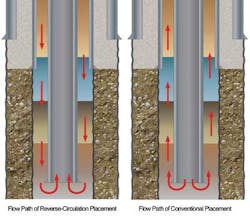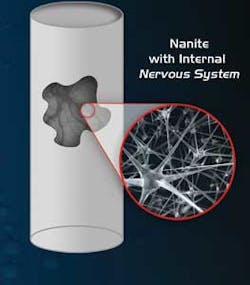Research effort aims to enhance cement integrity in deepwater
Project targets real-time monitoring with 'smart' mud
Roy Long
National Energy Technology Laboratory
US Department of Energy
Improving cement integrity in deepwater applications is one of the primary foci of the National Energy Technology Laboratory (NETL), a division of the US Department of Energy. Within NETL's national laboratory system, under the direction of the Office of Research and Development, and in concert with industry and academia, work is advancing in many areas, from reverse circulation cementing to smart cement. The following describes three projects designed to monitor and enhance cement integrity in deepwater environments.
Measuring electrical resistivity in smart cement
This ongoing project, undertaken by the University of Houston with partner Baker Hughes and funded by DOE through the Ultra-Deepwater and Unconventional Natural Gas and Other Petroleum Resources Research and Development Program administered by the Research Partnership to Secure Energy for America (RPSEA), seeks to develop technology for real-time monitoring of cement installation and performance during the service life of deepwater wells. In this study, various technologies will be used to develop "smart" drilling mud and cementing slurry with enhanced sensing properties, so that they can be deployed for real-time monitoring during installation and the entire service life of a deepwater well.
Advances in materials and grouting technologies will be combined with advancements in surfactant technology to produce drilling mud and cementing materials with enhanced sensing capabilities. With the sensing capabilities installed in the drilling mud and cementing slurry, it also will be possible to monitor the advancement of the drilling mud and cementing slurry front around the casing during the construction phase.
The smart drilling mud and cement slurry will be modified such that its short-term and long-term piezoresistive characteristics reflect the composition, chemical reactions, and surrounding environment (temperature and pressure) that influence changes in internal stresses. Changes in stress, strain, and/or temperature will cause a change in the electrical resistivity of the smart fluid, reflecting the condition of the cement slurry in the borehole and measuring, for example, the length of cement supporting the casing.
The long-term piezoresistive characteristics will be influenced by the stresses induced in the borehole and the condition of the solidified cement materials. The casing will be modified with outside rings at a set spacing to monitor the changes in the electrical resistivity and temperature of the drilling mud and cementing material that stabilize the casing and the borehole. This will make it possible to identify the locations that are highly stressed in the cement sheath surrounding the pipe. In addition, other damages caused by the stresses and temperature conditions in the borehole will be identifiable during the service life of the cemented casing.
The technical study will be completed in three phases over a total of three years. In Phase 1, smart drilling mud (SDM) and smart cementing slurry (SCS) will be developed with conductive fillers (solutions and particles) and fibers that do not affect the flowability characteristics of the drilling mud or cement slurry. The SDM and SCS will be characterized based on filtering, fluid loss, piezoresistivity, and rock interaction. In Phase 2, small and large model tests are planned to demonstrate the potential for the new fluids. In the final phase, a field demonstration will be carried out jointly by the research partners.
Deepwater cementing
With conventional primary cementing, fluids are pumped down the casing and then up the annulus; while with reverse circulation primary cementing (RCPC), the fluids are pumped down the annulus and up into the casing through the casing shoe. Using RCPC reduces the bottomhole circulating pressure of the fluids as compared to conventional cementing. The primary objective of this project, conducted by Cementing Solutions Inc. (CSI) with partners Weatherford and the University of Houston, is to assess the applicability of RCPC techniques to deepwater wells.
One major challenge in deepwater cementing is the narrow formation fracture gradient, so the application of RCPC has clear beneficial potential. However, the applicability of RCPC has not been evaluated for use in a challenging deepwater environment. The scope of work includes analysis of the RCPC cementing method, preparation of a development path for technology required to apply RCPC to deepwater wells, and creation of preliminary operational procedures with associated contingency plans. The application of RCPC to deepwater wells is expected to reduce bottomhole circulating pressures and prevent lost circulation during cementing as well as increase safety, strengthen environmental sustainability, enhance zonal isolation, and improve cement seals.
In Phase I of the project, the current state of RCPC technology and practices will be assessed and documented. Analysis will include numerical modeling and simulations, and assessments of mechanical placement controls and cementing materials. A laboratory study will be conducted on the performance of cementing additives spacers and the effect of RCPC on material performance. Based on these findings, potential benefits as well as the technical issues that need to be addressed before RCPC can be used for deepwater applications will be identified.
Phase II of the project will focus on the operational performance of RCPC and the functional considerations of applying RCPC on a deepwater rig. Phase I results will be used to determine technical issues that need to be addressed before routine deepwater RCPC applications can occur. Further analysis will include RCPC simulations and laboratory analyses under real well conditions and scenarios. Operational plans will include potential contingency situations during the application of RCPC.
Nano impregnated cement
Honolulu-based Oceanit Laboratories Inc., supported by DOE funding, is exploring oil and gas well applications for its nanotechnology concrete mix that was created as a means for strengthening material for use in buildings, bridges, and roads.
Companies worldwide are working on ways to incorporate so called carbon nanotubes into concrete. In addition to increasing toughness, the nanotubes, which are thousands of times thinner than a human hair, are highly conductive. That means that they could be used to create a kind of nervous system within concrete that could be used to detect cracking and weaknesses in structures.
However, many hurdles remain in the path of the promising technology, including high costs and technical barriers such as how to create a commercial nanoconcrete manufacturing process. Oceanit has worked to solve a key problem — how to homogeneously mix the tiny nanotubes into a thick fluid such as cement. The company is seeking to patent a process in which nanotubes are suspended in a liquid concentrate that is added to the water used to make cement.
The company is developing technology for road and bridge use in coordination with state and county transportation officials. Initially, the nanoconcrete would be tested for durability and strength. Ultimately, the company hopes the technology will revolutionize the way the structural integrity of concrete is monitored, though that application could take some time to develop.
"The carbon nanotube mixture we're patenting acts like a spider web within the concrete," said Oceanit spokesman Ian Kitajima. "Stresses in the concrete material are sensed by this internal web. Small pulses of electricity are sent through this nano-web within the concrete. Changes in the web reflect changes in cement structure, which affects the return signal that could be used to determine the health of a building."
For now, any use of nanotechnology in cement will be limited to specialized applications because nanotubes cost more than their weight in gold. "It is a very expensive material today, but it's being produced in higher and higher quantities every year," Kitajima said.
Potential transportation applications include portions of roadways and bridges that need stronger construction material or require more intensive monitoring, said Barry Fukunaga, director of the Hawaiian Department of Transportation. "It's a real innovative kind of a product that they've come up with," he said. "It's the kind of thing where it may be more costly, but in certain applications it could be a good investment because of its durability and sensing qualities."
Through the current DOE partnership, Oceanit is studying deepwater and problematic well cementing applications.
Editor's Note: For further information about the "smart cement" project or the deepwater reverse-circulation primary cementing project, contact Bill Head at RPSEA ([email protected]/281-313-9555) or C. Vipulanandan at the University of Houston ([email protected]/713-743-4278). For further information about the nano impregnated cement project, contact Roy Long at NETL (roy. [email protected]/281-494-2516) or Vinod Veedu at Oceanit ([email protected]/713-357-9622).


